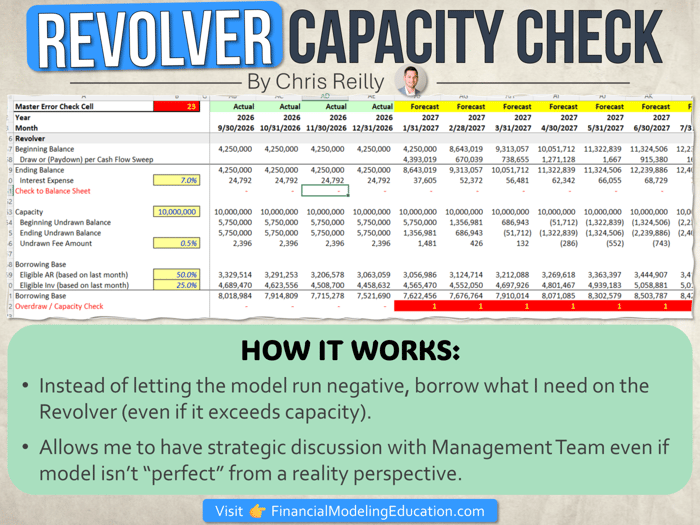Sometimes we get so caught up in the perfection of our Financial Models that we lose sight of their actual purpose: helping us make decisions (aka actually doing stuff in the real world).
To that end, here’s a mistake I include in every model on purpose…
Breaking the Revolver
I’m talking about how I model a “Revolver.”
A “Revolver” is just a fancy term for “giant credit card” that companies often have on their balance sheets.
A Revolver works like this:
Option 1:
If the business doesn’t have enough cash, I “draw” on the Revolver.
(↑ this just means I borrow from it, like your credit card)
Option 2:
If the business has too much cash, I will (usually) pay down the Revolver.
(↑ often called a “sweep”, the same as paying down your credit card)
“I’m at Capacity”
Just like you have a credit limit, the Revolver has a “capacity,” meaning you can’t borrow more than [$X].
In the picture above it happens to be $10mm (you can see it in the middle).
Now, if I wanted to be perfectly accurate, then…
if I exceeded the Revolver Capacity, then technically the cash in the business should go negative.
But, this is where we can draw a nice line in the sand and remember:
The model is an abstract representation of the business to help us make decisions.
(↑ and NOT the business itself)
Staying Practical
Now contrarily,
If I just “let the model run” and allow the Revolver to “draw” (borrow) whatever it needs to, it helps me communicate something to my team:
✓ I can say, “based on our expected operations this year, I think we will exceed capacity on our Revolver and need to either (1) work on a reforecast, (2) ask for a larger Revolver, or (3) both.”
✓ In addition, I know exactly how much we’ll need because my model tells me.
(↑ I’ll round up just a little for room)
It’s a much cleaner conversation than:
Me: “Looks like cash is going negative.”
Boss: “Why?”
Me: “Not sure, let me look into the model. Okay looks like we’re at capacity on our Revolver.”
Boss: “How much are we over?”
Me: “The Revolver capacity plus the negative cash amount.”
Boss: “So what do we need?”
Etc., etc., etc…
Embracing the Tradeoff
See what I’m saying?
Making the model perfectly accurate actually slows me down in this instance and creates confusion.
Whereas, if I build checks/indicators around major business issues, it allows the model to provide insight and help us make decisions as a team.
✓ That’s the point of the model: just accurate enough that I have some runway to make a decision on what to do next.
I get no prize or bonus points for it being pretty or perfect.
But, I guarantee you we’ve created value if the model starts a strategic conversation with our lender and we come to terms on a larger Revolver.
That’s it for today. See you next time.
— Chris
p.s., if you enjoyed this post, then please consider checking out my Financial Modeling Courses. As featured by Wharton Online, Wall Street Prep, and LinkedIn Learning, you'll learn to build the exact models I use with Private Equity and FP&A teams around the world. 👉 Click here to learn more.

